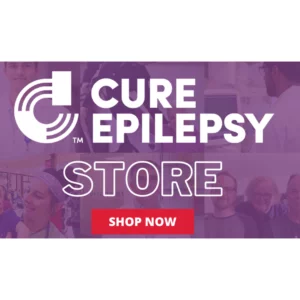Season’s Greetings Epilepsy Community!
As 2023 draws to a close with all of the accompanying anticipation, joy, and celebration, I remain incredibly moved and energized by our recent attendance at the Partners Against Mortality in Epilepsy (PAME) and American Epilepsy Society (AES) meetings. We connected with so many members of our research community, including current and former CURE Epilepsy grantees. We were thrilled to announce our newest cohort of grantees and see the ranks of our CURE Epilepsy-funded research community grow. We met with industry partners to get updates on the development of new treatments and therapies, we sat in scientific symposia to learn about the latest advancements in understanding the biological mechanisms behind seizures, and we met with our advocacy partners to collaborate on efforts to raise awareness, provide information to our community, and increase funding for research. My team left with even more ideas, connections, and motivation than ever before!

But, we are not done yet. There is still a need for a cure, and we are unrelenting in our mission. With 2024 will come new research and continued hope for the future. As we ring in the new year, we are honored to be a resource for the epilepsy community as we all strive towards finding a cure for this common and often devastating neurological disorder.
With gratitude,
![]()

In this CURE Epilepsy Update, please find information on:
- Our Newest Grantees
- Help Bring Us Closer to a World Without Epilepsy
- Joey’s Song Live Event and Online Auction
- Coming Soon: Epilepsy Explained, a New Video Series from CURE Epilepsy
- A New Full-Length Movie to Fight Epilepsy Stigma is in the Works
- Infantile Spasms Awareness Week Recap
- CURE Epilepsy at AES Annual Meeting
- What’s New from the Seizing Life® Podcast
- The CURE Epilepsy Store
Our Newest Grantees
CURE Epilepsy is honored to announce our newest CURE Epilepsy Award and Taking Flight Award grantees. We look forward to sharing how their research advances the field of epilepsy in the future. Learn more about each of our grantees and their research.
Help Bring Us Closer to a World Without Epilepsy
Scientific research is the greatest hope for the estimated 150,000 people diagnosed with epilepsy each year in the US. We rely on your continued generosity to help shape the future of epilepsy research. Make your end-of-year gift today to help ensure that no good science goes unfunded.
Joey’s Song Live Event and Online Auction
Looking to have a rocking night out or find a great gift for that musician in your life while also supporting epilepsy research? Buy your tickets now for Joey’s Song, taking place January 6 in Madison, Wisconsin. Joey’s Song is a concert started in 2010 in honor of Joey Gomoll, a child with Dravet syndrome who passed away at four years old. The mission of Joey’s Song is to raise epilepsy awareness and money for epilepsy research and programs for children with special needs. Can’t attend in-person? You can also bid in the online auction for signed items from R.E.M., Sheryl Crow, Noel Gallagher of Oasis, Eddie Vedder of Pearl Jam, and more!
Coming Soon: Epilepsy Explained, a New Video Series from CURE Epilepsy

Next month we’ll be launching a new video series, Epilepsy Explained, where epilepsy experts will answer community questions on all sorts of epilepsy topics in short, easy to understand clips. Keep an eye out for the first episode going live on Wednesday, January 17!
A New Full-Length Movie to Fight Epilepsy Stigma is in the Works
The short film Under the Lights, which was discussed in a 2022 Seizing Life podcast episode with film director and epilepsy advocate Miles Levin, is being made into a full-length movie, with big stars and bigger hearts to fight stigma via the big screen.
Infantile Spasms Awareness Week Recap
Each year, the epilepsy community designates the first week of December as Infantile Spasms Awareness Week. This year, CURE Epilepsy and other consortium partners highlighted what infantile spasms (IS) is, how to identify the signs, why it is a medical emergency, and more. If you missed the content earlier this month, review it now here.
CURE Epilepsy at AES Annual Meeting

Members of the CURE Epilepsy team were educated, motivated, and inspired at the 2023 AES Meeting. We saw new and familiar faces at our CURE Epilepsy reception, announced our latest grantees, attended presentations on new research from former grantees, and more. We look forward to participating in the 2024 AES Meeting next year!
What’s New from the Seizing Life® Podcast
Regenerative Brain Cell Therapy: One Woman’s Journey to Seizure Freedom
Annette Adkins, who has lived with intractable epilepsy since 2014, discusses the impacts of epilepsy on her professional and personal life, and how it led her to participate in a revolutionary clinical trial for regenerative stem cell therapy that has brought her seizure freedom.
Infantile Spasms: The Facts, The Research, and The Hope for the Future
In recognition of Infantile Spasms Awareness Week, we spoke with epilepsy research scientist Dr. Chris Dulla of Tufts University about infantile spasms – what we know, what recent research has revealed, and how current research may lead to better detection and treatments.
Watch these and all of our upcoming Seizing Life episodes here.
The CURE Epilepsy Store

Help raise awareness for epilepsy and the need for a cure with CURE Epilepsy apparel or accessories.
1 in 26 individuals will be impacted by epilepsy in their lifetime.
Each person has their own story.

































